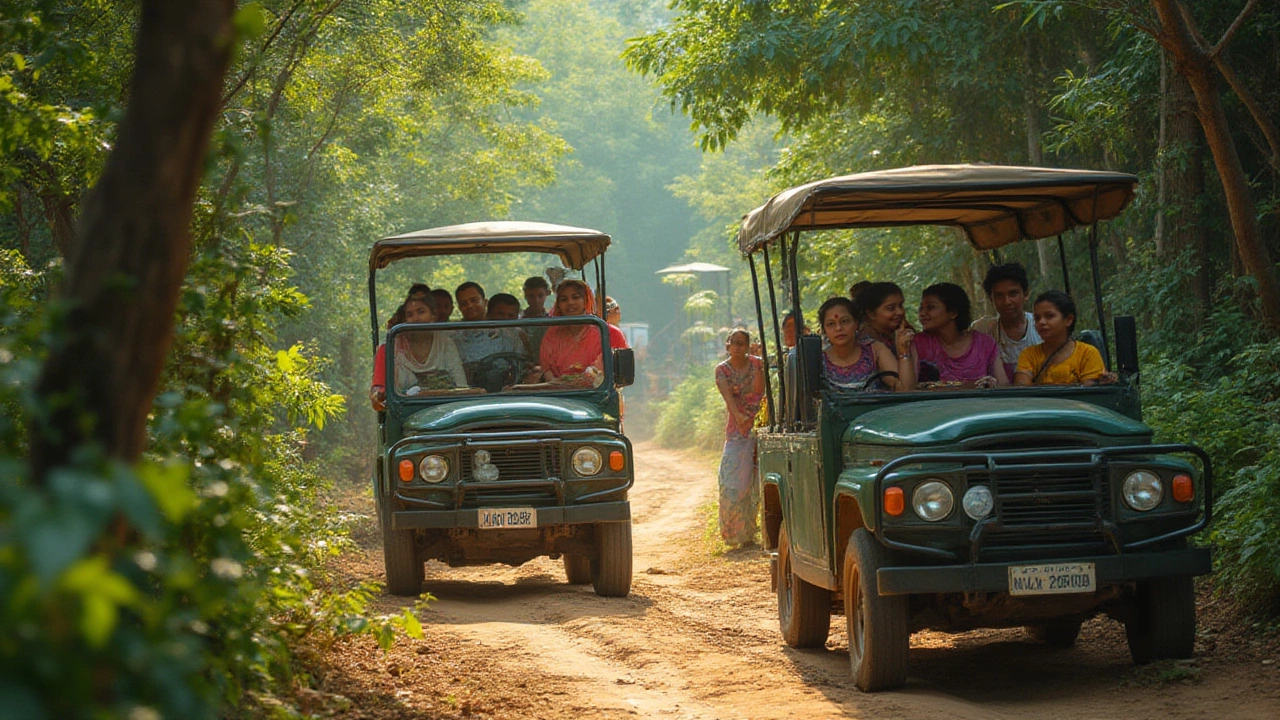If you think wildlife sanctuaries are just peaceful nature spots surviving on donations, think again. The truth is, sanctuaries in India are hustling with creativity, sometimes ruffling feathers in the conservation world, just to keep their gates open and animals fed. They walk a tightrope between pure-hearted rescue work and clever business strategies—because, let's be honest, nothing wild or tame survives on good intentions alone.
The Reality Behind Sanctuaries and Their Finances
Go to any sanctuary’s website and it’s all gentle images: deer grazing, peacocks strutting, lost lions with soulful eyes. What they don’t post up top is the spreadsheet—the one with utility bills, salaries, and massive animal food invoices. The average wildlife sanctuary in India spends lakhs every month simply to survive. Even something as simple as feeding a herd of rescued elephants can cost upwards of ₹10,000 a day, considering how much one elephant packs away. That’s without counting medicine, regular health checkups, maintenance, water bills, and staff housing. Most sanctuaries are run by trusts or non-profits. Donors think their money goes right to the animals, but it’s a nonstop juggle between urgent animal rescues and the less adorable reality of repairing fences, paying taxes, or funding legal wranglings when new development projects swallow up forest land.
Contrary to the rosy idea that sanctuaries are supported by endless donations, most have to scramble to cover even basic costs. According to a 2023 survey by the Wildlife Trust of India, more than 60% of sanctuaries reported having to dip into emergency reserves just to cover off-season expenses, when tourists and donors vanish. Big government or celebrity-funded sanctuaries sound glamorous, but most small-to-medium ones are quietly in survival mode, fund-raising through bake sales, auctions, and Sunday events where you can “adopt” a tiger for a day. Some even rent out their grounds for weddings—imagine saying “I do” while monkeys squabble in the trees above.
Maybe you’ve visited sanctuaries with glossy signboards or fancy eco huts for overnight guests. That’s another revenue stream: wildlife tourism. Guest fees, parking charges, guide services, jeep safaris—every rupee helps. There’s an ongoing debate about whether this “wildlife for sale” angle cheapens the conservation message, but most sanctuary directors know the stark reality. Without a strong income, the animals lose much more than their privacy.
You might wonder about international grants and NGO partnerships. They’re important for special projects—like anti-poaching patrols or habitat restoration—but rarely cover daily expenses. Grants are often restricted, meaning you get rupees only for a new animal hospital or research equipment, not for buying milk, rice, or basic vet care. So the day-to-day money comes down to entry fees, curious visitors, and a surprisingly large amount of merchandise sales. Who knew that a tiger mug or dancing peacock fridge magnet could help keep the wolves at bay?
Revenue Streams: From Entry Fees to Ecotourism
Okay, so how do sanctuaries actually pull in money? Turns out, it’s a mixed bag. The classic revenue stream is the visitor entry fee. For popular places like Ranthambore or Periyar, tens of thousands of people pay good money just to catch a glimpse of a wild tiger or elephant. At ₹50 to ₹500 per person, those tickets add up fast on weekends or holidays. But here’s the twist: a huge chunk goes to the state government, not always directly to the sanctuary’s operations. Local sanctuaries trying to get a slice of the pie sometimes have to work with complicated revenue-sharing models. If you own a less-famous sanctuary or one tucked far from big cities, you’re not seeing those numbers.
Another big-ticket item: guided safaris. Many sanctuaries offer private jeep rides or walking tours for an extra charge—sometimes ₹2,000 to ₹5,000 for a family group. These provide crucial direct income (and jobs for local guides). In 2022, Corbett Tiger Reserve brought in nearly ₹13 crore just from safari bookings. Smaller places can’t dream of such figures, but even modest tours help pay for animal care and basic infrastructure.
Merchandise is surprisingly profitable. Next time you buy a t-shirt with a sloth bear or leopard print at a sanctuary gift shop, you’re giving more than pocket change to the animals. Popular sanctuaries like Bandhavgarh have turned souvenirs into an art, partnering with local artisans and eco-friendly brands. Even hand-crafted clay whistles or painted bookmarks make a dent in the feeding bills. Plus, these products serve as reminders that conservation works best when the whole community benefits.
More recently, some sanctuaries have set up eco-resorts and homestays nearby. Think treehouse accommodations, fireside dinners, and guided birdwatching for visitors. These aren’t just for rich tourists. Even a simple weekend getaway can run ₹4,000-₹7,000 per night, making a big impact on sanctuary finances. Some sanctuaries, like the Agumbe Rainforest Research Station, use guest stays to fund snake rescue, education, and research. The secret is balancing the number of visitors so as not to overwhelm the fragile ecosystem while still paying the bills.Sanctuaries also make money by organizing special experiences—photo tours, night patrol walks, or animal keeper-for-a-day programs—which work well with curious city folk or school groups. The fees for these programs are usually higher, since people pay a premium for unique memories and behind-the-scenes access.
Corporate partnerships are another lifeline. Companies sponsor rescue projects, educational camps, or even whole habitats—sometimes for branding, sometimes for real conservation motives. In 2023, Tata Group funded several water management projects for sanctuaries in central India, which ended up benefiting not just the animals but the neighboring villages too. While no sanctuary director dreams of billboards with corporate logos next to a tiger enclosure, these funds often keep projects alive where donation fatigue threatens to kill them.

Challenges: Keeping Money Flowing Without Losing Sight of Conservation
Money coming in is never simple. Sanctuaries face criticism from purists who believe wildlife protection should be 100% charitable. But the ground truth is, keeping a safe, healthy habitat for wild animals is expensive, and strict government regulations keep many sanctuaries from going all-in on commercial ventures.
Often, the biggest stress comes during off-seasons when visitor numbers plummet. For example, during the heavy rains of August-September, most sanctuaries in India close to tourists because roads wash out, or trails become too dangerous. The sanctuary’s expenses, though, don’t dip. Staff still need to be paid, animals still eat, and repairs stack up when the weather is rough. Many sanctuaries run fundraising marathons online during these slow months. Crowdfunding, social media campaigns, virtual tours, and online donation drives have all become part of the annual cycle. Even my friend Sam, who runs a bird sanctuary in Rajasthan, started monthly Zoom birdwatching classes to make ends meet when the pandemic shut tourist gates for nearly two years.
There’s also the sticky business of permits and compliance. Sanctuaries must stay within legal frameworks, especially about how much land they can use for eco-tourism, what they can build, and who they can hire. One wrong step, and you’re tangled in a pile of paperwork—sometimes with heavy fines or even temporary shutdowns. The Wildlife Protection Act and Forest Conservation Act have noble aims but leave little wiggle room for quick business pivots. That’s why creative revenue ideas, like selling compost made from sanctuary waste or hosting environmental workshops for paying audiences, have popped up as clever sideline hustles.
Another hard challenge: not all sanctuaries want to turn into tourist hotspots. Some are dedicated rescue or rehabilitation centers, closed to the public for good reason—sensitive animal cases or endangered species that can’t handle human crowds. These sanctuaries lean almost entirely on big-ticket donors or international animal welfare networks. Keeping cash flowing here is even tougher; without prying eyes, the animals are safer, but the funding pipeline is thinner. Sometimes, sponsors “adopt” an animal virtually and get updates and photos—a link to the “product,” so to speak, without any visitor ever crossing the fence.
For-profit sanctuaries do exist, but they aren’t the norm in India. These places usually run on a mix of heavy entry fees, entertainment-style shows, and sometimes even commercial breeding—which is a hot debate in animal circles and looked down on by most conservationists. The grand majority remain nonprofit, working overtime to convince public and private donors that their money is going to real impact, not just pretty newsletters.
Practical Tips: Supporting Sanctuaries and Sustainable Choices
If you want sanctuaries to keep doing what they do and survive the ups and downs, there are some really practical ways to help out—especially if you care about wild animals beyond sharing viral videos online. First up: visit sanctuaries, but do it responsibly. Pay for entry fees, buy legitimate merch, and book official tours or activities. Every ticket, t-shirt, and keepsake mug chips away at the daily budget that keeps animals healthy and care staff paid.
Look for sanctuaries that are transparent about how they use their funds. The best ones post annual reports online, break down where donations go, and make it easy to ask questions. If you can swing a recurring donation—even small, like ₹200 a month—it has a bigger impact than a one-time gift. Sanctuaries can plan ahead when they know some money’s coming regularly, especially in slow visitor months.
Get your workplace involved. Many companies these days match employee gifts or organize corporate eco-volunteering days. If your office hosts fundraisers during the holidays, suggest directing some portion to a sanctuary you’ve visited or researched. Or gift an “adopt an animal” package for birthdays, wedding gifts, or kids’ school projects; it’s a lot more memorable (and useful) than another throw pillow or yoga mat.
Take time to learn about the sanctuary’s real needs—sometimes it’s not money, but supplies, expertise, or even helping out with website design or social media promotion. My wife Claire once volunteered for a month teaching English to kids living near a tiger reserve, and it ended up building long-term networks that boosted both the school and the sanctuary’s visitor outreach.
If you’re curious about running a sanctuary or working in animal care, remember that passion is just the starting point. You’ll need some pretty sharp skills in fundraising, operations, digital marketing, and crisis management. Even long-time animal lovers who set up their own sanctuaries have to adapt fast—one viral story can bring a flood of attention (and visitors), while a bad monsoon can knock out your income for weeks.
The simplest way to keep sanctuaries in business? Celebrate the honest ones who balance conservation and clever revenue ideas. Skip the ones that exploit animals for pure entertainment or use fake rescue stories to rake in cash. Let’s be honest—when sanctuaries thrive financially and ethically, everyone wins, especially the animals. And that’s worth every rupee and every bit of honest hustle.
